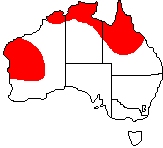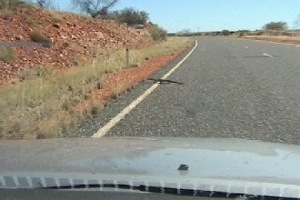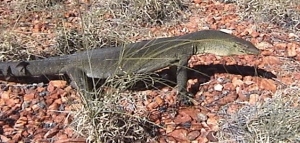|
Yellow Spotted Monitor
|
- Order: Squamata (scaled reptiles)
- Suborder: Lacertilia (=Sauria) (lizards)
- Family: Varanidae (monitor lizards)
- Genus: Varanus (monitor lizards)
|
| Also known as: Yellow
Spotted Goanna |
Scientific Name: Varanus panoptes
panoptes="all-seeing;" a
reference to the eyelike spots on some specimens' backs |
| Habitat: A variety of
environments ranging from woodland to arid regions. |
|
| Length: About four feet
total. |
|
| Food: Insects and
small vertebrates. |
 |
|
This monitor lizard (or "goanna," a
corruption of the word "iguana") was leisurely crossing
the road just north of Devil's Marbles Conservation Area in
Northern Territory. Unfortunately for me, it was at a bend
in the road, and I didn't see it until I was VERY close to it, and
I was traveling pretty fast. In an effort to avoid running
over the goanna, I swerved off the road and almost lost control of
my car! After regaining my composure, I returned to find the
monitor departing the opposite side of the road (first picture),
where it took refuge among the clumps of grass. |
 |
| At first, the goanna tried to
lie motionless in the hopes that I wouldn't notice it (second
picture). Naturally, this was not the case. As I
approached closer, the lizard abruptly stood up high on all four
legs, inflating its body and throat and sticking out its tongue to
make itself appear more threatening (final picture). After a
few more seconds, it turned and ran back across the road on its
hind legs. |
 |
| This was the first wild lizard I
found it Australia, and it was very exciting! We don't have
lizards this big in the United States! |
 |
| I had trouble identifying the
particular species to which this goanna belonged, so I consulted
Mr. John Fowler, who maintains the Reptiles
of Australia web site along with John Hollister. This
species is easily confused with Gould's Monitor, also known as the
sand goanna (Varanus gouldii). In fact, there is
still a debate over the actual identity of the "type
specimen" of the sand goanna--it may actually be a
yellow-spotted monitor! This only adds to the
confusion. However, as Mr. Fowler notes, the sand goanna
usually has a yellow tail tip, and the monitor I found did not,
which means it is most likely a yellow-spotted monitor. Many
thanks to Mr. Fowler for his assistance!
Also, thanks to Michael Durbin for assisting with the etymology
of the scientific name.
|
|
|
|
|